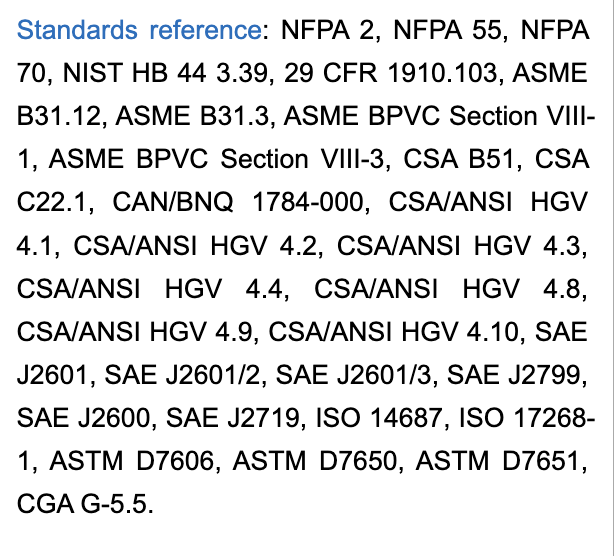Hydrogen On-Site, Safely: What Fleet Operators Need to Know About Dispensing for Trucks & Forklifts
On-site hydrogen fueling can feel unfamiliar, but with modern safeguards and trained operators, it’s safe, efficient, and ready to keep your fleet moving.

Is On-Site Hydrogen Fueling Safe for Fleets?
When you’re responsible for a trucking fleet or a warehouse full of fuel-cell forklifts, the idea of installing on-site hydrogen generation and dispensing can feel like a leap. Hydrogen is high-pressure, invisible, and new to many operators. Sensible questions follow:
1. Is it safe?
2. Will it keep our fleet moving?

Modern hydrogen dispensing systems are designed to answer both with a yes. The fueling process is governed by well-defined standards. With layered safeguards—leak detection, ventilation interlocks, emergency stops, breakaway couplings, pre-cooling, and certified mass-flow metering—hydrogen fueling has become predictable and routine
ESSNA™ adds one more layer: every fill is handled by a trained operator and / or remote monitoring. That means procedures are followed consistently, alarms are monitored in real time, and your vehicles leave the island safely—every time.
Hydrogen is not Dangerous, Just Inherently Unforgiving – Gareth Gregory ESSNA™
Why Fleets Hesitate About On-Site Hydrogen Fueling
Hydrogen fueling operates at up to 700 bar (10,000 psi +), far exceeding CNG dispensing and a different discussion to diesel and propane dispensing standards. Hydrogen also diffuses quickly and is odorless, so you can’t “smell a problem” but a well designed rational fire design ensures adequate airflow / ventilation. These realities require the integration of a professional hydrogen team
The key point: these risks are engineered and operationally managed. Dispensers implement conservative fueling protocols, enforce temperature and pressure limits, and transition to a safe state automatically when anything is out of order. Physical interlocks (different nozzle/receptacle geometries) prevent accidental connection between pressure classes. And because ESSNA™ runs fueling with trained operators (in certain cases remotely), you’re not relying on ad-hoc training or first-time users in a busy yard.
Hydrogen Dispensing Safety Features That Protect Fleets
Hydrogen dispensing relies on independent, overlapping layers—so one fault does not become an incident.
ESSNA™: A Partner for Every Hydrogen Supply Model
At ESSNA™, we don’t force customers into one model. Instead, we provide the most cost-effective and reliable hydrogen solution for your unique operation.
Hydrogen Dispensing Accuracy: How Metering Protects Your Bottom Line
Hydrogen is dispensed by mass (kg) using Coriolis meters designed for compressed gases and certified to recognized metrological standards such as OIML R139.
That provides:
- Auditable accuracy for finance and compliance
- Fair internal chargebacks across divisions or vehicles
- Confidence that billed amounts match actual fuel delivered
Hydrogen Fueling Process: What Fleet Operators and Drivers Can Expect
With ESSNA™’s operator-led model, the process is straightforward:
- The operator performs pre-checks and authorizes the dispenser.
- The nozzle locks into the vehicle receptacle; interlocks confirm a secure connection.
- The dispenser runs safety checks, selects the fueling protocol, and sets pre-cooling.
- Fueling proceeds under supervision; mass is continuously metered.
- The system auto-stops at the target; the operator depressurizes and disconnects.
Typical duration: Forklift fills are brief by design to support multi-shift operations. Light-duty H70 vehicles typically fuel in a few minutes. Medium/heavy vehicles depend on tank size and flow class but are engineered for shift planning. At ESSNA™ we design for the objective, guaranteeing these parameters.
Designing Safe and Reliable On-Site Hydrogen Fueling Stations
A reliable station is as much about layout and procedure as hardware. Best practices include:
- Clear approach and egress lanes with bollards and signage
- Emergency stop buttons within reach of fueling positions
- Operator-led fueling for every transaction
- Routine checks of hoses, nozzles, and sensors
- Stocked spare parts and service contracts with hydrogen specialists
Who Is Using Hydrogen Today: Forklifts, Trucks, and Buses
Hydrogen adoption is no longer theoretical. Leading companies already use it daily:
- Toyota Material Handling and Raymond: Proven hydrogen forklifts for high-volume, multi-shift warehouses
- Toyota and Hyundai: Passenger cars and fuel-cell buses operating in commercial service
- Hyundai, Hyzon and Nikola: Class-8 hydrogen trucks entering freight service in North America
- Ballard Power Systems: Fuel-cell stacks deployed in buses, trucks, and forklifts worldwide
- Cummins: Integrating hydrogen fuel cells into heavy-duty transport platforms
- ESSNA™: Delivering modular systems across North America
For fleet operators, these examples demonstrate that hydrogen is reliable at scale — across multiple vehicle categories.
Preparing Hydrogen Fueling Systems for Heavy-Duty Fleets
As adoption expands, new standards and hardware will support heavier vehicles and denser operations. Expect to see:
- Higher-capacity dispensers and additional fueling positions
- Larger pre-cooling systems to handle larger volumes
- Enhanced vehicle–station communications
- Modular station growth, adding storage and dispensers as demand grows
Choosing scalable infrastructure today ensures your site can adapt to tomorrow’s fleet requirements.
Hydrogen Dispensing: Safe, Efficient, and Ready for Fleets
Hydrogen dispensing systems are engineered for safety and throughput. With fueling protocols, independent hardware safeties, leak-detection interlocks, certified metering, and robust pre-cooling, hydrogen fueling is routine and reliable.
ESSNA™ closes the loop with operator-led fueling. For fleet operators, that means predictable uptime, safe procedures, and a clear path to lower carbon intensity without adding operational risk.
Hydrogen Dispensing FAQs for Fleets and Forklifts
Is on-site hydrogen fueling safe?
Yes. Dispensers implement multiple safety systems, and ESSNA™ technical supervises the operation.
How long does fueling take?
Forklifts fuel in minutes. Light-duty vehicles take 2–5 minutes. Heavy trucks are designed for efficient turnaround.
How accurate is the billing?
Certified Coriolis meters ensure precise, auditable billing by kilogram.
What happens if a driver pulls away with the nozzle still attached?
Breakaway couplings seal both ends of the hose, and the dispenser transitions to a safe state.
Do staff need special training?
No. ESSNA™ provides trained operators. Your staff receive only a short orientation unless contracted to be run independently.
Want to explore hydrogen dispensing for your site? Contact us at: https://www.energysecurity-na.com/contact-us

